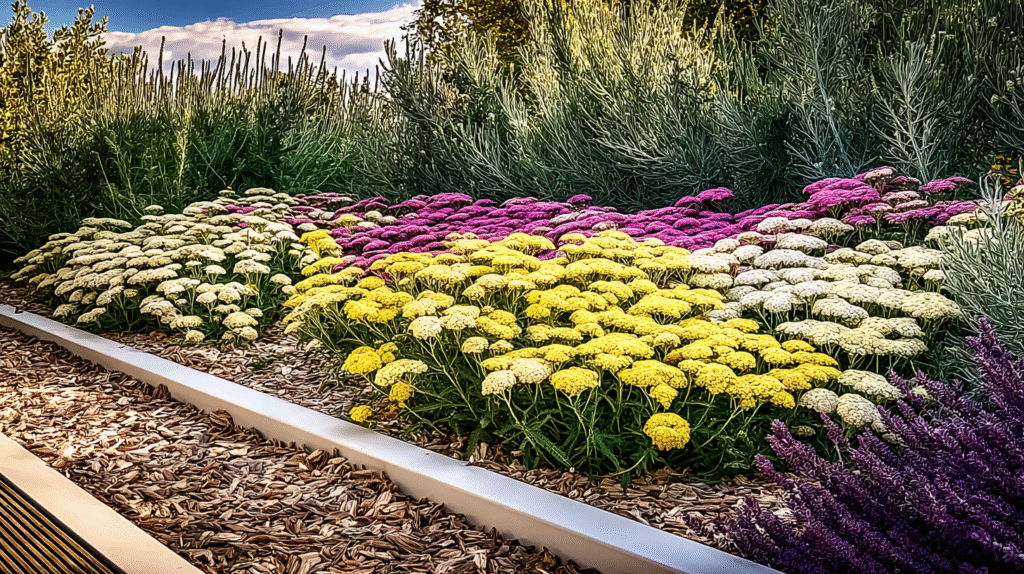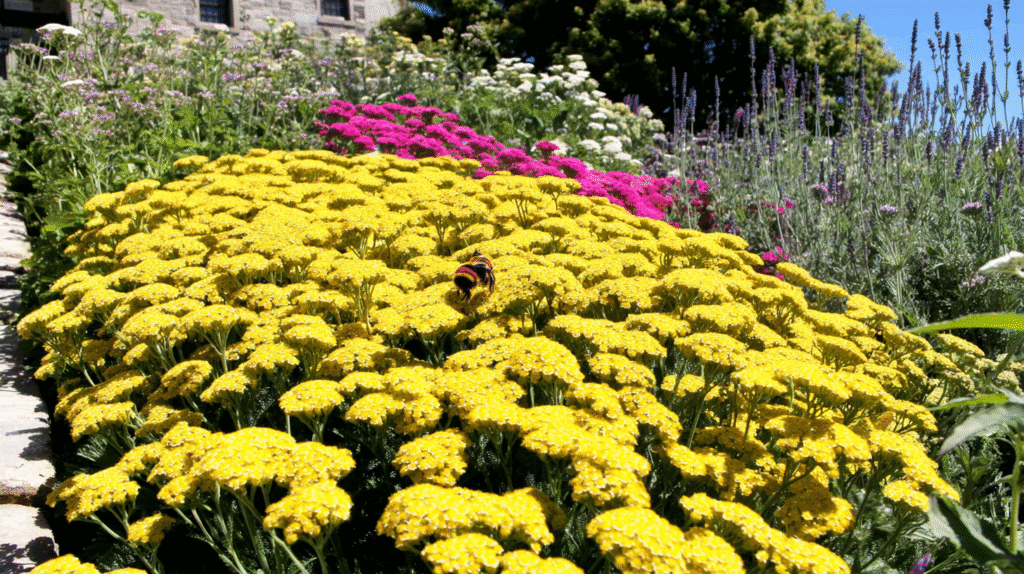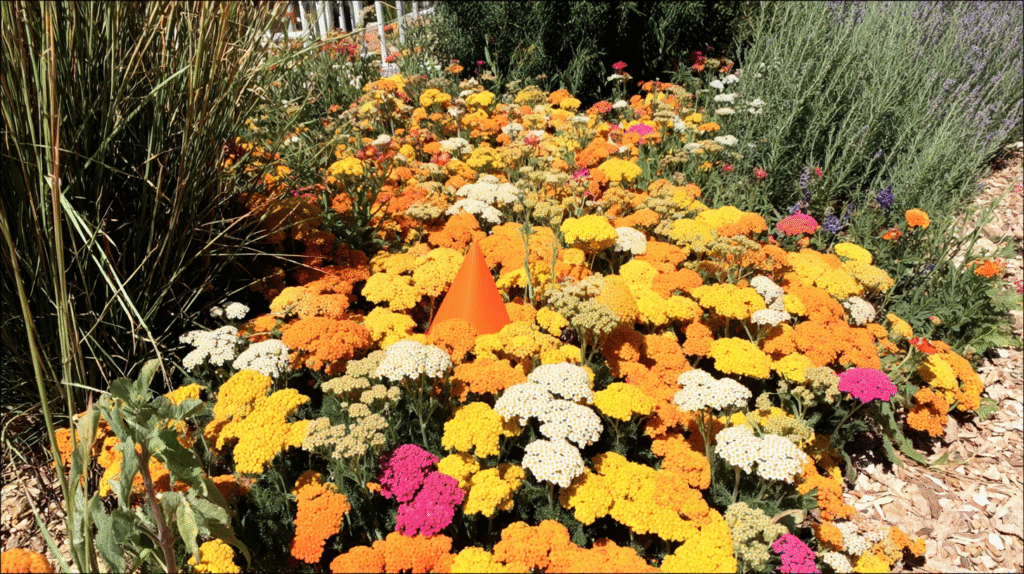I spent three hours ripping out what I thought were weeds from my new garden bed. Feathery leaves, spreading everywhere – obviously invasive, right? My neighbor watched from her porch, occasionally shaking her head. Finally, she walked over and delivered the news that still makes me cringe: “Hon, that’s yarrow. People pay good money for that.”
I’d just destroyed about $50 worth of established Achillea millefolium. But that embarrassing mistake launched my love affair with one of the most underrated perennials out there. Five years later, my yard is a yarrow wonderland that has bees lining up like it’s a botanical buffet.
My Yarrow Wake-Up Call
After the great yarrow massacre, I did what any mortified gardener would do – obsessive research. Turns out, I’d yanked out a plant that:
- Attracts more beneficial insects than almost any other perennial
- Thrives on neglect (perfect for lazy gardeners like me)
- Comes back year after year, spreading into a gorgeous ground cover
- Has been used medicinally for thousands of years
The kicker? That patch I destroyed had probably been establishing itself for years. I’d basically ripped out garden gold because I didn’t know better.
Why Yarrow Deserves a Spot in Every Garden
Here’s what converted me from yarrow destroyer to yarrow evangelist:
It’s Practically Immortal My yarrow has survived:
- A week of 100°F temperatures with no water
- An ice storm that killed my supposedly “hardy” roses
- My toddler nephew using it as a wrestling mat
- Three years of zero fertilizer
The Wildlife Factor Last summer, I counted 14 different pollinator species on my yarrow in a single afternoon. Bees, butterflies, beneficial wasps, even hummingbirds. My neighbor (the one who witnessed my yarrow massacre) now calls my yard “the neighborhood bee spa.”
Blooms for Months While my other perennials give me a few weeks of glory, yarrow starts blooming in June and keeps going until October. Cut it back when it looks tired, and boom – fresh flowers in two weeks.

Starting Yarrow: Easier Than You Think
After my initial disaster, I’ve successfully grown yarrow from seeds, transplants, and divisions. Here’s what actually works:
From Seed (The Cheap Way):
- Start indoors 8-10 weeks before last frost
- Or direct sow after frost danger passes
- Seeds need light to germinate – don’t bury them
- Germination takes 14-21 days (be patient)
- Success rate: About 70% for me
From Nursery Plants (The Easy Way):
- Spring or fall planting works great
- Look for plants with multiple stems
- Avoid any with yellowing leaves
- Expect to pay $6-12 per plant
- Success rate: Nearly 100%
From Divisions (The Free Way):
- Best done in early spring or fall
- Dig up established clump, split with a spade
- Each division needs roots and growing points
- Water well after planting
- Success rate: 100% if you don’t overthink it
Planting Yarrow: Location Matters More Than You’d Think
My first intentional yarrow planting failed because I babied it. Rich soil, daily watering, prime garden real estate. It grew tall, floppy, and barely bloomed. Here’s what yarrow actually wants:
Sun Requirements:
- Full sun is best (6+ hours)
- Tolerates part shade but gets leggy
- More sun = more blooms = more pollinators
Soil Preferences:
- Average to poor soil (seriously)
- Well-draining is crucial
- Sandy or rocky soil? Perfect
- Clay soil needs amending with sand or gravel
Spacing:
- Plant 12-24 inches apart
- They will fill in gaps quickly
- Closer spacing = ground cover effect
- Wider spacing = individual specimen plants

The Care Routine That Took Me Years to Figure Out
Watering:
First year: Water weekly until established After that: Only during extreme drought Overwatering causes floppy stems and root rot
Fertilizing:
Don’t. I mean it. Fertilizer makes yarrow grow tall and floppy with fewer flowers. My unfertilized yarrow looks better than my neighbor’s pampered plants.
Deadheading:
Cut spent flowers to keep blooms coming I use the “hack and hope” method – cut the whole plant back by half when it looks tired New growth appears within days
Dividing:
Every 3-4 years to maintain vigor Spring division settles in faster Fall division works but needs winter mulch
Varieties That Actually Perform (Not Just Look Pretty in Catalogs)
I’ve tried dozens. Here are the winners:
‘Moonshine’ (My Favorite)
- Bright yellow flowers that don’t fade
- Silver-gray foliage
- 18-24 inches tall
- Never flops, even in rain
‘Paprika’
- Opens red-orange, fades to creamy yellow
- Color changes create a multicolor effect
- Great cut flower
- Spreads moderately
‘Cerise Queen’
- Hot pink flowers
- Vigorous spreader
- Taller variety (2-3 feet)
- Bees go absolutely nuts for it
Common White Yarrow
- The “weed” I originally pulled
- Toughest of all varieties
- Spreads readily (contain if needed)
- Best for naturalizing
Common Problems I’ve Faced (And Fixed)
Powdery Mildew Happens in humid summers with poor air circulation. Solution: Space plants properly and avoid overhead watering. I just cut affected parts off – yarrow bounces back fast.
Floppy Stems Usually from too much water or fertilizer. I stake tall varieties in early summer or just let them sprawl naturally. The pollinators don’t care if it’s messy.
Aggressive Spreading Some varieties are enthusiastic spreaders. I either divide regularly or plant them where spreading is welcome. My “Cerise Queen” is slowly taking over a difficult slope, and I’m thrilled.
The Yarrow Garden Combinations That Work
Through trial and error, I’ve found these pairings create stunning, low-maintenance displays:
For a Drought-Tolerant Border:
- Yarrow + Russian Sage + Sedum
- Add ornamental grasses for movement
- Mulch with gravel for drainage
For a Pollinator Paradise:
- Yarrow + Echinacea + Black-eyed Susans
- Include native milkweed
- Leave seed heads for winter interest
For a Cottage Garden Look:
- Yarrow + Lavender + Catmint
- Let them weave together naturally
- Add a few roses for height
Harvesting and Using Your Yarrow
Beyond the garden beauty, yarrow has practical uses:
For Fresh Cut Flowers:
- Cut in morning when stems are firm
- Choose flowers just opening
- Lasts 7-10 days in vases
- Mix with other garden flowers
For Dried Arrangements:
- Cut when fully open but before they fade
- Hang upside down in dark, dry area
- Keeps color for months
- Great for wreaths and crafts
For Herbal Uses:
- Harvest leaves and flowers when blooming
- Dry for teas (traditional use for centuries)
- Always research and consult professionals before using medicinally
My Yarrow Garden Now: A Complete Transformation
Five years after the great yarrow massacre, my garden tells a different story. What started as an embarrassing mistake has become the backbone of my pollinator garden. I have six varieties of yarrow creating rivers of color from June through October.
The bee activity is insane – I actually have to warn visitors to watch where they step. Butterflies use it as a landing pad. Beneficial wasps that control garden pests treat it like a five-star hotel. My vegetable garden has never been more productive, thanks to all the pollinators yarrow attracts.
Best part? I spend maybe 20 minutes a year maintaining all of it. A spring cleanup, occasional deadheading, dividing every few years. That’s it. While my neighbors slave over their fussy perennials, my yarrow thrives on neglect.

The Bottom Line on Growing Yarrow
If you want a plant that:
- Attracts clouds of pollinators
- Handles whatever weather throws at it
- Spreads into a maintenance-free ground cover
- Provides months of colorful blooms
- Actually prefers poor soil and minimal water
Then yarrow is your answer. Just learn to identify it first – don’t be like me and spend an afternoon destroying garden gold. Start with one plant this spring. By next summer, you’ll understand why I went from yarrow killer to yarrow evangelist. Your local bees will thank you, and you’ll wonder why everyone isn’t growing this incredible perennial.
Trust me – the only thing better than a yarrow-filled garden is not having to replant it every year. 🌼






